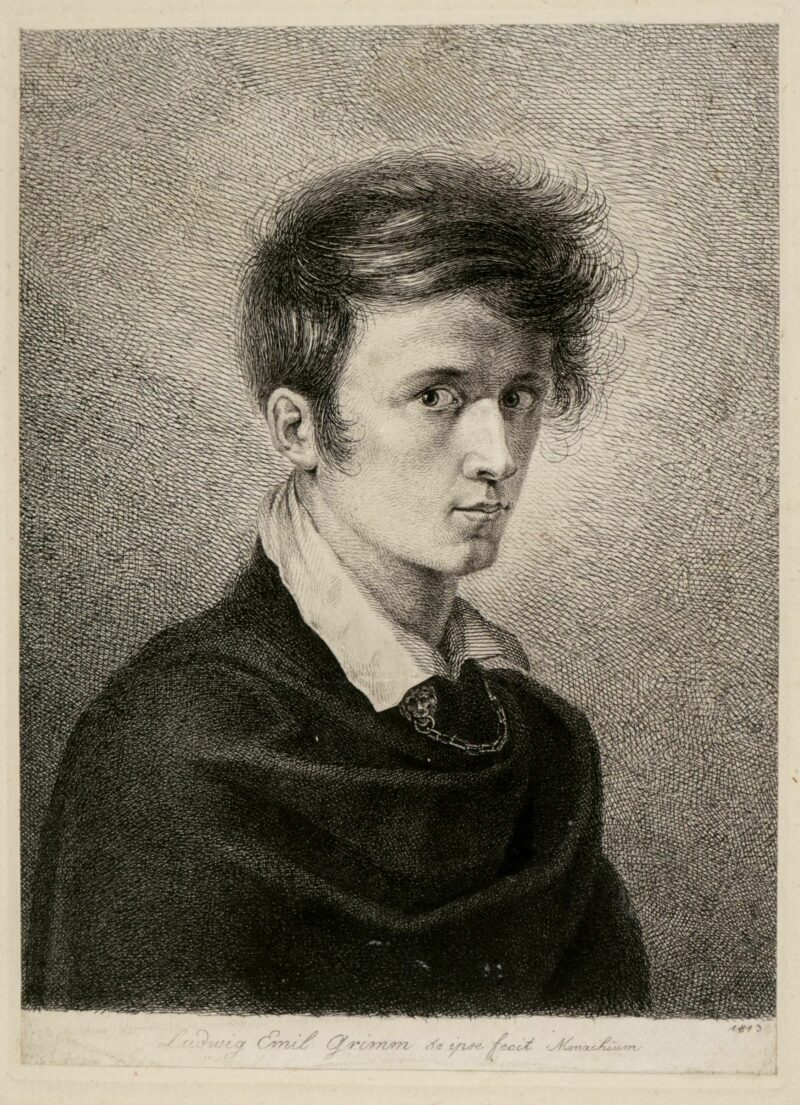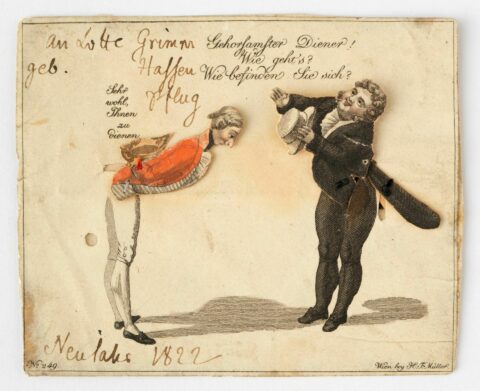- Menu
- Today
-
Next event
Die GRIMMWELT von A-Z
Special Exhibition
I, ANIMAL
Permanent Exhibition
GRIMMWELT adventure space
from Dr. Vera Leuschner
© Grimm-Sammlung der Stadt Kassel, Graph_0045-I_03 | Illustration: Ludwig Emil Grimm
Jacob und Wilhelm Grimm’s youngest brother Ludwig Emil Grimm (1790-1863), usually known as ‘Louis’, was a highly acclaimed painter, illustrator and etcher.
After studying at art school in Kassel and Munich, he became a professor at the Kassel Art Academy in 1832. Part of his work is not only practically a chronicle of his brothers’ lives, but also of social life in the city of Kassel.
Ludwig Emils inclination to draw ‘from life’ was already apparent while he was still at school at the Lyceum, which is now the Friedrichsgymnasium grammar school: doodles and caricatures in his exercise books were passed around and often got him into trouble with his teachers. The works that portrayed what he had seen and experienced remained his greatest strength throughout his life.
Although the ‘painter brother’ respected and admired Jacob and Wilhelm’s learning and intellect, he had no such scholarly ambitions himself. However, the brothers had frequent opportunities to work together, for example when the artist drew the fairy tale narrator Dorothea Viehmann in 1815, not long before her untimely death. She was a woman with an incredible talent for storytelling who contributed many texts for the second volume of the Grimms’ Fairy Tales collection. Her likeness – it was to remain the only surviving image of her – then appeared as an etching (after the original drawing) in the 1819 fairytale edition, which is on display in the BUCH section. Later, the draughtsman also helped the brothers to illustrate their fairy tales, also displaying his great talent as an inventor. Some examples of the printed works can be viewed in the VOLKSMÄRCHEN section.
Some of Ludwig Emil’s humorous pieces are on show in the CASSEL section, such as the animated discussion at distinguished assembly in the house of the famous anthropologist and anatomist Professor Blumenbach in Göttingen. Grimm used to enjoy elaborating humorous drawings like this with text passages that give the observer the feeling that he or she is almost participating in the discussion.
© Grimm-Sammlung der Stadt Kassel, Hz_0183_01_N | Illustration: Ludwig Emil Grimm
© Grimm-Sammlung der Stadt Kassel, Hz_1380_01_N | Illustration: Ludwig Emil Grimm
© Grimm-Sammlung der Stadt Kassel, Autogr_0011_02_N | Illustration: Ludwig Emil Grimm
© Grimm-Sammlung der Stadt Kassel, Hz_0182_01_N | Illustration: Ludwig Emil Grimm
The astonished visitors are then confronted with two extremely long showcases placed in parallel one behind the other, which contain 10-metre long roll-up drawings laid flat: the “Travel Journal in Pictures” of 1850 and the “Short Description Of The Life Of A Strange And Lovable Sow” (1849/50). Both rolls consist of numerous individual pages from sketchbooks stuck together by the artist. The format – sketches accompanied by longer or shorter comments, some of them in direct speech, others in dialect – mean that these rolls are not only a precursor of the modern comic format, but also follow the principle of a film show unreeling before our very eyes. With his sharp wit – frequently combined with subtle irony – a feeling for the comic potential of a situation and a humorous view of everyday mishaps, Grimm traces the grotesque juxtaposition of primary and secondary scenes and pithily commits it to paper.
In The Travel Journal, the 60-year-old Grimm depicts the “Adventures” that he, his wife Friederike, his daughter Ideke and his niece Dorothee experienced on a journey from Kassel to Nuremberg via Fulda, Steinau (his old hometown), Frankfurt am Main, Aschaffenburg, Würzburg and Bamberg. The Grimms’ legendary reputation as excellent mimics is evident when, for example, Gottschalk – an old friend from his youth in Steinau – constantly repeats his “coffee-table promises” but never keeps them, or when the lanky landlord Eckhardt points to the storks and confidently asserts: “You see, Mister Grimm, them storks come every year, and every year they come”. The viewer cannot fail to smile when the innkeeper in Gelnhausen attempts to ‘talk posh’ and says he “has the honour to wish you a bon appetite”. In addition, the Travel Journal roll is a treasure trove of the cultural history of mid-19th century travel.
In the case of the so-called “Sow Roll”, the observant viewer will find not only drastic comedy and subtle irony, but also numerous hidden allusions to the political situation around 1848 and thereafter.
Visitors will be delighted by this small selection from Ludwig Emil Grimm’s drawing work, which consists of around 2,000 sheets in all. Other sections of his work, such as landscapes, genre and local costume studies, further portraits and history pictures are preserved in the art warehouse of the City of Kassel’s Grimm Collection.




